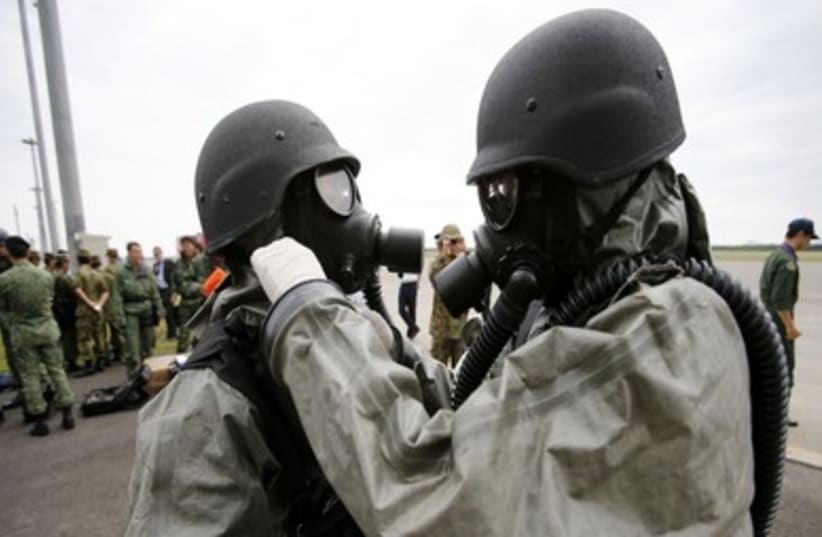“Gas! GAS! Quick, boys! – An ecstasy of fumbling, Fitting the clumsy helmets just in time; But someone still was yelling out and stumbling And flound’ring like a man in fire or lime....As under a green sea, I saw him drowning.In all my dreams, before my helpless sight, He plunges at me, guttering, choking, drowning.”
The British themselves appear to have been the first to use gas in the Middle East, during the Second Battle of Gaza against the Ottoman Turks in April 1917 – although, one chronicler reported, the gas shells “were too few to produce the expected results.” At war’s end, gas had killed some 100,000 soldiers on all sides and maimed over a million. The trauma was so great that in 1925, a protocol was signed in Geneva prohibiting the use of poison gas in warfare.But the fascination with poison gas persisted. “I do not understand,” Winston Churchill had noted in 1919, “this squeamishness” about the use of gas: “It is sheer affectation to lacerate a man with the poisonous fragment of a bursting shell and to boggle at making his eyes water by means of lachrymatory gas. I am strongly in favour of using poisoned gas against uncivilised tribes. The moral effect should be so good that the loss of life should be reduced to a minimum. It is not necessary to use only the most deadly gasses: gasses can be used which cause great inconvenience and would spread a lively terror and yet would leave no serious permanent effects on most of those affected.”There was little squeamishness in this regard during the 20th century. It was long alleged that the British used poison gas against rebellious Assyrian tribes in northern Iraq in 1921. That charge was disproved, but other “uncivilized tribes” were not so lucky.The Spanish used mustard gas against Berber rebels in northern Morocco between 1921 and 1927. During the Italians’ 1935-36 invasion of Ethiopia, mustard gas was used liberally and even observed by Dr. Marcel Junod of the Red Cross.Junod’s reports were suppressed by his organization, whose president later testily explained that the reason was “not indifference or lack of courage” but the “responsibilities” of “a body which must always remain capable of offering to all parties a guarantee of the most objective possible judgment....”In the modern era, Egypt used gas during the civil war in Yemen between 1963 and 1967 (with a short break for the Six Day War) but denied the charge. The United Nations General Assembly issued a condemnation, but secretary general U Thant said he was “powerless” in the matter. The Soviet Union used gas against civilians during its long Afghan war, and Syria apparently used gas against Muslim Brotherhood rebels in Hama in 1982.The epitome of modern chemical warfare occurred during the 1980-88 Iran-Iraq War. Iraq initiated the war in September 1980, and by November, in a desperate response to Iranian human wave tactics, was using gas. In 1984 Iraq became the first nation ever to use nerve gas. Many Western countries had provided Iraq with dual-use technologies and precursor chemicals; Egypt and China helpfully supplied specialized munitions. In 1988 Iraq also used gas against rebellious Kurds, killing perhaps 15,000. In the immediate aftermath, the US government blamed Iran; the Central Intelligence Agency maintained this position into the 1990s.Deterred by US and Israeli weaponry, Iraq did not use chemical weapons against the Americans during 1991 or 2003 or against Israel. For the same reason, however, Israel, despite a series of missile strikes against it in 1991, did not use unconventional weapons against Iraq.Perhaps the 21st century will be different.But Russia still maintains that reports of Syrian chemical weapons are just rumors. Syrian officials call the reports false, mere lies being spread to justify a Western invasion – indeed, Syria says US and European governments may actually have given chemical weapons to terrorists within Syria so that the West can later claim their use by the Syrian government. Such claims will resonate locally, recalling Egypt’s assertion that the charges of its use of gas in Yemen were a conspiracy to cover up “Israel’s use of napalm during the Arab-Israeli war.”But the question raised by Churchill’s characteristic bluntness – whether the means of slaughter matters – lies at the root of the issue.Western countries and Israel have accepted international accords on chemical weapons and, more important, have culturally internalized their prohibitions. Even so, the West has abetted, averted eyes, and forgiven when chemical weapons have been used. Elsewhere in the world, instrumentality regularly overwhelms morality and the fig leaf of international law, leaving only deterrence and retribution as protections.The only real difference in Syria today is the significant probability that the Assad regime will collapse and its chemical and biological weapons fall into the hands of Islamists possessed of a different moral and political calculus. That prospect should spread its own “lively terror.” Whether it will be enough to prompt a Western invasion of Syria remains to be seen.
Chemical warfare in the Middle East: A brief history
Western countries and Israel have accepted international accords on chemical weapons and have culturally internalized their prohibitions.
